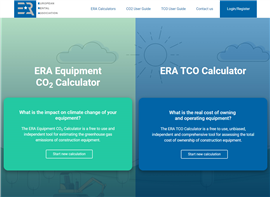AI boom spawns data centre gold rush in new cities
02 June 2025
A surge in demand by tech companies for data centres to host new AI capabilities is prompting a construction boom which is being experienced well beyond established locations. Neil Gerrard finds out why.
 Abu Dhabi. Last month OpenAI announced plans to partner with other tech firms to build a huge AI data centre in the city. Photo: Adboe Stock
Abu Dhabi. Last month OpenAI announced plans to partner with other tech firms to build a huge AI data centre in the city. Photo: Adboe Stock
The artificial intelligence boom is driving a gold rush into data centre construction as investors scramble to build a new generation of giant buildings which house the backbone of the internet.
Consultants say that demand for AI models such as Google’s Gemini or OpenAI’s GPT-4, is prompting investors to pour billions into the sector, spawning a building boom reaching well beyond established data centre locations.
Last month OpenAI announced plans to partner with other firms to build a huge artificial intelligence data centre in Abu Dhabi, the capital of the United Arab Emirates as part of the company’s first large scale project outside the USA. The company said that the new data centre would have a capacity of 1 gigawatt, making it one of the most powerful in the world.
And last week Arizona Land Consulting, a data centre fund backed by tech investors including Silicon Valley venture capitalist Chamath Palihapitiya, announced it had closed a US$51 million land deal to build a data centre in Arizona.
“Exponential growth”
“We’re seeing exponential growth driven by AI and digital consumption,” says Richard Battey, director at cost consultants, Currie & Brown and head of data centres for the UK and Europe. “While the market plateaued a bit a few years back, it’s ramped up again. Projections for the next four to five years still show strong growth.”
According to a recent Currie & Brown report, this surge in demand, coupled with high energy costs, regulatory demands and new environmental rules, is leading European developers to look beyond the established data centre markets of Frankfurt, London, Amsterdam, Paris and Dublin – a group of cities known in the trade by the unwieldy acronym ‘FLAP-D’ which for decades have been favoured by data centre developers due to their high levels of connectivity, availability of skilled labour and established infrastructure.
In 2022, Irish state-owned grid operator EirGrid imposed a de facto moratorium on data centres development in Ireland saying that it would not consider new load requests until 2028. Meanwhile Frankfurt is becoming less appealing to new data centre occupiers because the country still relies heavily on fossil fuels to generate its electricity. And quickly rising wages for construction workers in London and Frankfurt are increasing costs and lengthening project timelines.
 Richard Battey, director and head of data centre UK and Europe, Currie & Brown
Richard Battey, director and head of data centre UK and Europe, Currie & Brown
The change in strategy is likely to mean lucrative construction jobs for contractors and major equipment rental deals for the rental companies able to service them.
“There’s still a drive to go into the FLAP-D regions but there are big restrictions in terms of power availability in the likes of Frankfurt and Dublin. If you haven’t got the permits in place now for data centres, then there are restrictions on where you can build,”
With increasing pressure on tech firms to reduce their carbon footprints as much as possible, Battey says companies are paying careful attention to the energy mix in each potential location.
“There’s heavy investment right now into renewable energy sources - solar, wind, hydro - to power data centres,” says Battey. “It’s about aligning with the global drive toward energy efficiency and carbon neutrality.”
Countries with a high share of renewable energy, like Italy, have a natural advantage. But sustainability is also shaping how facilities are built and operated.
And, equipment that supports low-emission construction methods, modular approaches, and advanced cooling technologies is increasingly in demand.
Battey notes rapid adoption of innovations such as liquid immersion cooling, which was a central focus at recent industry events. Microsoft’s prior experimentation with underwater data centres may not have scaled commercially, but it signals how far operators are willing to go in search of efficiency gains.
Instead, he says investors and developers hoping to build new European data centres are looking to Milan in Italy as a more cost-effective and easier alternative.
“It’s geographically well positioned in southern Europe and acts as a connection point between major markets like Germany, France and Switzerland,” he says. “There’s a growing digital economy in Italy, especially post-pandemic, and Milan sees the highest concentration of demand for digital services.”
Italy’s northern business hub is supported by robust digital infrastructure and home to the Milan Internet Exchange (MIX), one of the country’s most significant interconnection points. More importantly, the Lombardy region offers a favourable energy profile, generating 11,000 GWh from hydroelectric sources and 1,500 GWh from solar annually.
Italy’s relatively moderate wage inflation—forecast at 2% in 2025 compared to 4.6% across the eurozone—adds another layer of appeal, particularly for contractors grappling with rising input costs elsewhere.
“The National Recovery and Resilience Plan (NRRP) includes major investment in digitalisation, plus tax incentives and streamlined permitting processes,”
Battey notes. “There’s also funding support for youth and tech initiatives, which includes data centre developments.”
Major players such as AWS, Microsoft and Google are already investing heavily in Milan. For equipment providers, that means increased demand not just for traditional plant, but also for cutting-edge cooling, backup power, and sustainable construction solutions.
Milan leads the pack
While Milan may be drawing the most attention, it is not alone. Madrid, with its strong infrastructure and lower development costs, is also rising fast.
“There’s a lot going on there right now,” Battey says. Currie & Brown is engaged in multiple projects around the Spanish capital.
Other emerging markets include Poland—although geopolitical uncertainty related to Ukraine continues to dampen investor appetite—Portugal, and Switzerland, which maintains a steady flow of high-cost development.
Another emerging idea gaining traction in North America is the co-location of small modular reactors (SMRs) for independent, low-carbon power generation.
“It’s generating a lot of interest,” Battey says. “AWS has been looking into it in the US. There are conversations about it in the UK too, but the challenge is the security and regulatory hurdles that come with nuclear tech. There’s promise there, but it’s not imminent.”
Yet, as Battey points out, risks persist. Geopolitical uncertainty, supply chain fragility, and potential trade tariffs could disrupt momentum.
“There’s a bit of a storm brewing,” he warns. “Things like trade tariffs could impact construction material costs and disrupt supply chains. It’s a buoyant market right now, but those headwinds could slow things down.”
STAY CONNECTED



Receive the information you need when you need it through our world-leading magazines, newsletters and daily briefings.
CONNECT WITH THE TEAM









